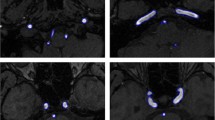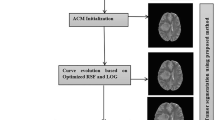Abstract
Precise segmentation of vasculature from three-dimensional (3D) magnetic resonance angiography (MRA) images is playing an important role in image-guided neurosurgery, pre-operation planning and clinical analysis. Active Contour based evolution algorithms are being widely applied to MRA data sets, however existing approaches exhibit some difficulties in extracting tiny parts of the vessels. Our objective is to develop an automated segmentation scheme to accurately extract vasculature of the brain, especially tiny vessels. Inspired by the intrinsic properties of MRA, we have proposed a scheme called the gradient compensated geodesic active contours (GCGAC), which compensates for low gradients near edges of thin vessels. The GCGAC, which is implemented based on level set, has been tested on both synthetic volumetric image and real 3D MRA images. Our experiments show that the introduced gradient compensation can facilitate more accurate segmentation of tiny blood vessels.














Similar content being viewed by others
References
Osher, S., & Fedkiw, R. (2003). Level set methods and dynamic implicit surfaces. New York: Springer.
Yan, P., & Kassim , A. A. (2005). MRA image segmentation with capillary active contour. Proceedings of the international conference on medical image computing and computer assisted intervention 2005, 1, 51–58.
Yan, P., & Kassim , A. A. (2006). MRA image segmentation with capillary active contours. Medical Image Analysis, 10, 317–329.
Frangi, A. F., Niessen, W. J., Hoogeveen, R. M., & Walsum, T. v. (1999). Viergever, model-based quantitation of 3-D magnetic resonance angiographic image. IEEE Transaction on Medical Imaging, 18, 946–956.
Suri, J. S., Liu, K., Reden, L., & Laxminarayan, S. (2002). A review on MR vascular image processing: Skeleton versus nonskeleton approaches: Part II. IEEE Transactions on Information Technology in Biomedicine, 6, 338–350.
Aylward, S. R., & Bullitt, E. (2002). Initialization, noise, singularities, and scale in height ridge traversal for tubular object centerline extraction. IEEE Transactions on Image Processing, 21, 61–75.
Kass, M., Witkin, A., & Terzopoulos, D. (1987). Snakes: Active contour models. International Journal on Computer Vision, 1, 321–331.
Malladi, R., Sethian, J. A., & Vermuri, B. C. (1995). Shape modeling with front propagation: A level set approach. IEEE Transactions on Pattern Analysis and Machine Intelligence, 17, 158–174.
Caselles, V., Kimmel, R., & Sapiro, G. (1997). Geodesic active contours. International Journal on Computer Vision, 22, 61–79.
Suri, J. S., & Laxminarayan, S. (2002). PDE and level sets: Algorithmic approaches to static and motion imagery. New York: Springer.
Suri, J. S., & Laxminarayan, S. (2003). Angiography and plaque imaging: Advanced segmentation techniques. CRC.
Kichenassamy, S., Kumar, A., Olver, P., Tannenbaum, A., & Yezzi, A. (1996). Conformal curvatures flows: From phase transitions to active vision conformal curvatures flows: From phase transitions to active vision. Archive for Rational Mechanics and Analysis, 134, 275–301.
Yezzi, A., Kichenassamy, S., Kumar, A., Olver, P., & Tannenbaum, A. (1997). A geometric snake model for segmentation of medical imagery. IEEE Transactions on Image Processing, 16, 199–209.
Siddiqi, K., Lauriere, Y. B., Tannenbaum, A., & Zucker, S. W. (1998) Area and length minimizing flows for shape segmentation. IEEE Transactions on Image Processing, 7, 433–443.
Siddiqi, K., Tannenbaum, A., & Zucker, S. W. (1998). Hyperbolic smoothing of shapes. International Conference on Computer Vision, 1, 215–222.
Brown, M. A., & Semelka, R. C. (1995). MRI: Basic principles and applications. New York: Wiley.
Adalsteinsson, D., & Sethian, J. A. (1995). A fast level set method for propagating interfaces. Computational Physics, 118(2), 269–77.
Acknowledgements
We wish to thank Prof. Wang Shih-Chang, Dr. Yeh Ing Berne and other clinicians from the Department of Diagnostic Radiology at National University Hospital of Singapore, specially prof. Wang Shih-Chang and Dr. Yeh Ing Berne, for their kind help and support.
Author information
Authors and Affiliations
Corresponding author
Rights and permissions
About this article
Cite this article
Zonoobi, D., Kassim, A.A. & Shen, W. Vasculature Segmentation in MRA Images Using Gradient Compensated Geodesic Active Contours. J Sign Process Syst Sign Image Video Technol 54, 171–181 (2009). https://doi.org/10.1007/s11265-008-0216-4
Received:
Revised:
Accepted:
Published:
Issue Date:
DOI: https://doi.org/10.1007/s11265-008-0216-4




